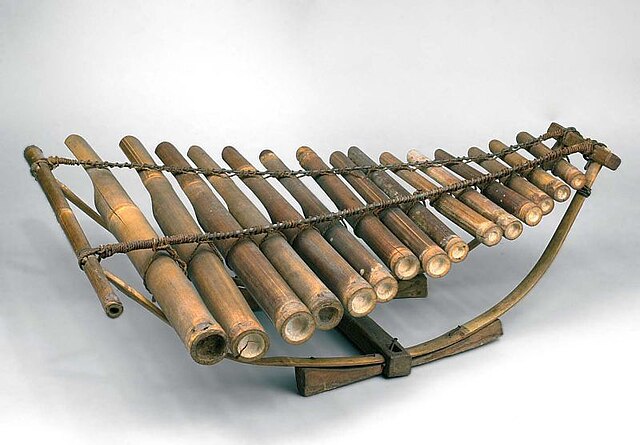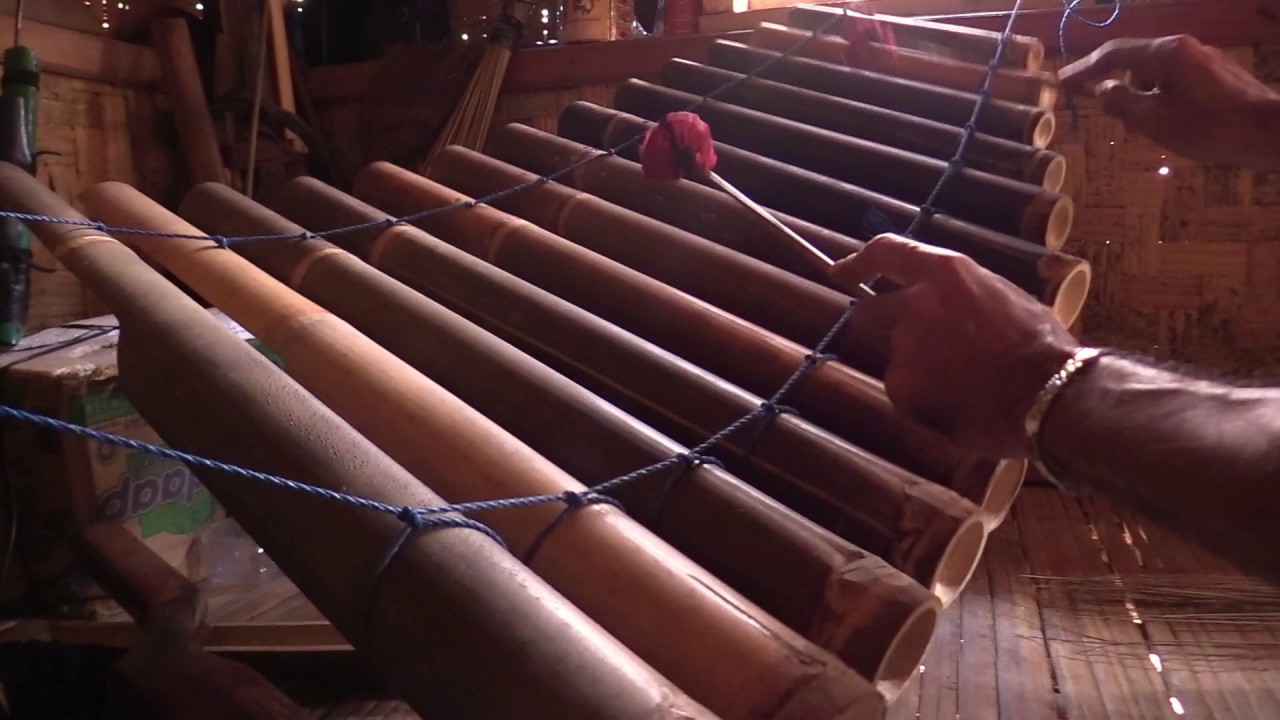Calung
Melodic Percussions
Asia
Between 1001 and 1900 AD
Video
The Calung is a traditional percussive idiophone originating from Indonesia, specifically the Sundanese culture of West Java. It is crafted primarily from bamboo, with each tube producing different pitches when struck. The instrument is unique for its resonant and melodic tones, achieved through the precise cutting and tuning of bamboo tubes. The sound produced is deep, earthy, and rich, making it a staple in Sundanese folk music.
The Calung belongs to the gamelan family, a set of instruments that are played together in an ensemble. Unlike metal-based gamelan instruments like the bonang or saron, the Calung is a bamboo xylophone and is often played in traditional rural performances. It shares similarities with the Angklung, another bamboo instrument from Indonesia, but differs in its playing technique and structure.
Types of Calung
There are two primary types of Calung, distinguished by their construction and playing technique:
- Calung Rantay – This type consists of multiple bamboo tubes strung together and laid out in a row. It is suspended on a frame, allowing for a standing performance where the player uses both hands to strike the bamboo tubes. Calung Rantay is commonly used in ritualistic and ensemble performances, where the melody is an integral part of traditional ceremonies.
- Calung Jinjing – Unlike the Rantay, Calung Jinjing consists of smaller sets of bamboo tubes that are held in the player’s hands while being played. It is often used for mobile performances, such as street performances and parades. Due to its portability, Calung Jinjing allows for more expressive and dynamic performances, especially when combined with dance movements.
Each type of Calung contributes to different cultural settings, with Rantay being more ceremonial and structured, while Jinjing is lively and interactive.
History and Origin
The Calung has a long history, deeply embedded in the culture of Sundanese and Javanese traditions. It is believed to have originated from the island of Java, Indonesia, around the 14th to 16th century, during the height of the Majapahit Empire. This period saw the development of gamelan music, where bamboo instruments began to emerge alongside metallic percussion instruments.
While the precise origin of the Calung is unclear, historical evidence suggests that bamboo instruments have been used in Southeast Asian music for over a thousand years. The Sundanese people, known for their love of nature and artistry, are credited with refining the Calung into its modern form. Over time, it evolved from a folk instrument used in agricultural rituals to a respected musical instrument in traditional ensembles.
The spread of the Calung throughout Indonesia and neighboring regions was influenced by trade, migration, and cultural exchanges. In later centuries, it became a symbol of regional identity, especially in West Java, Central Java, and parts of Bali.
Types and Features
The Calung, despite being a single instrument, can vary significantly in size, structure, and tuning depending on regional traditions.
Materials and Construction
Bamboo Selection: The Calung is primarily made from Awi Wulung (black bamboo) or Awi Tamiang (yellow bamboo). These bamboo types are chosen for their durability, resonance, and tonal quality.
Tube Arrangement: The bamboo tubes are arranged in a pentatonic scale, known as Slendro or Pelog, which are common in gamelan music.
Hollow Design: Each tube is cut and hollowed to produce specific pitches, ensuring that the instrument creates melodic harmonies when played.
Key Features of the Calung
Unlike Western instruments based on the diatonic scale, the Calung follows a five-note tuning system, which gives it a distinctive Southeast Asian sound. Unlike other xylophones played with mallets, the Calung is struck using bare hands, producing a softer, more natural tone. The bamboo tubes act as natural resonators, amplifying the sound without the need for external modifications. The Calung’s lightweight bamboo construction allows for easy transport and performance, making it an accessible instrument for many musicians.
Work Mechanics
The playing mechanics of the Calung are what make it unique compared to other idiophones. The method of playing varies depending on the type of Calung and the style of performance.
Playing Technique
The player holds the bamboo tubes in both hands (Calung Jinjing) or positions them on a wooden stand (Calung Rantay). Each tube is struck using the fingers and palm, creating a rhythmic and melodic sequence. Unlike metal gamelan instruments, which have a sharp, percussive attack, the Calung produces a warm, rounded tone due to the bamboo’s natural properties. Players often alternate between fast and slow strikes, creating syncopation and dynamic rhythm patterns.
Musical Expression
The Calung is highly expressive and can be used to play both solo and ensemble pieces. The pitch variations and rhythmic interplay allow for:
- Traditional folk songs and dances
- Religious ceremonies and spiritual music
- Theatrical performances and storytelling
Role in Music
The Calung plays an essential role in Indonesian musical culture, particularly in West Javanese folk music. It is often featured in Gamelan Degung and Gamelan Salendro ensembles, complementing other percussion and melodic instruments.
Traditional and Folk Music
In rural areas, the Calung is used in harvest festivals, celebrations, and village gatherings. Farmers and villagers play the instrument to accompany songs that tell stories of daily life, love, and nature.
Theatrical and Dance Performances
The Calung is commonly used in Wayang Golek (puppet theater) and Jaipong dance performances. Its rhythmic melodies enhance dramatic storytelling, making it an integral part of traditional Indonesian performing arts.
Modern Adaptations
In recent years, the Calung has been incorporated into modern fusion music, blending traditional bamboo sounds with contemporary instruments. Artists experiment with electronic effects and alternative tunings, bringing the instrument to international audiences.
Significance of the Calung
Beyond its musical role, the Calung holds deep cultural and symbolic importance in Indonesian society.
The Calung is a symbol of Sundanese heritage, representing the harmony between humans and nature. It embodies Indonesia’s rich musical traditions, serving as a reminder of the country’s historical and artistic legacy. Traditionally, the Calung was used in spiritual ceremonies, believed to ward off evil spirits and attract positive energy. In some regions, it is played during rituals to honor ancestors and deities.
The Calung is taught in Indonesian music schools, ensuring that future generations continue to learn and appreciate the instrument. Various organizations and cultural institutions promote Calung workshops and festivals, celebrating its significance.
FAQ
What is the historical origin of the calung instrument?
The calung instrument originates from the Sundanese culture in West Java, Indonesia, with its history dating back centuries. It is closely related to the angklung but is distinct in its playing method. The calung has been used in various traditional ceremonies and performances across Indonesia.
What type of instrument is the calung?
The calung is a type of bamboo xylophone, classified as a percussion instrument. It is part of the Sundanese gamelan ensemble and is known for its woody sound produced by striking bamboo tubes.
What material is the calung typically made from?
The calung is typically made from bamboo, with black bamboo (awi wulung) being the most common material used. Some calungs are also made from white bamboo (awi temen).
 Links
Links
References
Other Instrument
Categories



















